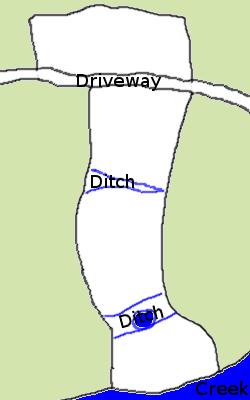
Pasture plan

 Our top choice for a pasture is the powerline
cut area down in the floodplain. The electric company chopped a
big swathe through the woods, and we can't let trees grow there, so we
might as well put it to use.
Our top choice for a pasture is the powerline
cut area down in the floodplain. The electric company chopped a
big swathe through the woods, and we can't let trees grow there, so we
might as well put it to use.
This weekend, I did some measuring and discovered that the open area
along the powerline is approximately one sixth of an acre. It
used to be farmed, long before we bought the land, so two ditches
bisect its width (and so does our driveway.) At the moment, I'm
thinking of using osage-orange
hedges to split the powerline cut into four paddocks along these
obvious dividing lines.
If we ever feel ready to have dairy animals, I've recently been
thinking our best bet would be miniature goats. They're short, so
fences don't have to be quite so intense, and they use less pasture per
animal so we might be able to fit in two does and a buck. With
four tiny paddocks, we'd be able to keep the buck separate and still
have room to rotate all the animals frequently to prevent overgrazing
and parasites. Of course, this is still very much in the dreaming
stages --- I expect our hedges to take anywhere from a year to five
years to be beefy enough to deter critters, and we still need to find
someone willing to milk when we're away from home!
Want more in-depth information? Browse through our books.
Or explore more posts by date or by subject.
About us: Anna Hess and Mark Hamilton spent over a decade living self-sufficiently in the mountains of Virginia before moving north to start over from scratch in the foothills of Ohio. They've experimented with permaculture, no-till gardening, trailersteading, home-based microbusinesses and much more, writing about their adventures in both blogs and books.
Want to be notified when new comments are posted on this page? Click on the RSS button after you add a comment to subscribe to the comment feed, or simply check the box beside "email replies to me" while writing your comment.

That's a good point. I'm hoping that if we keep the powerline cut low-lying, the power company will figure it's not worth their while to mess with it. After all, they clearly hadn't touched it for twenty years until we moved here.
I've heard some people saying you can put the kid back on the mother and some people saying you can't. Have you had firsthand experience with that? Did it make the mother stop producing as much milk?